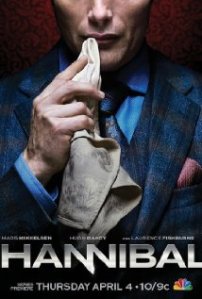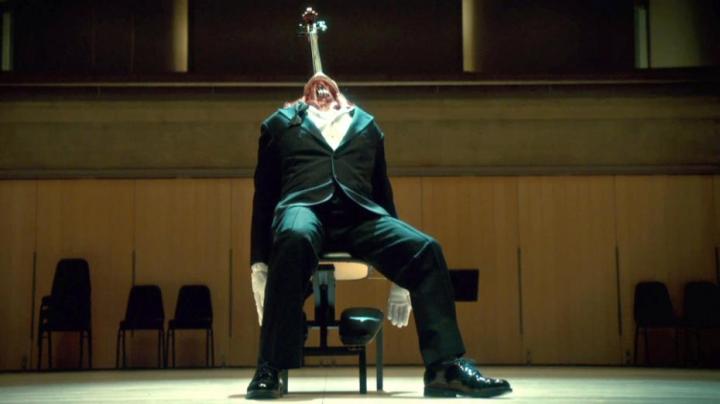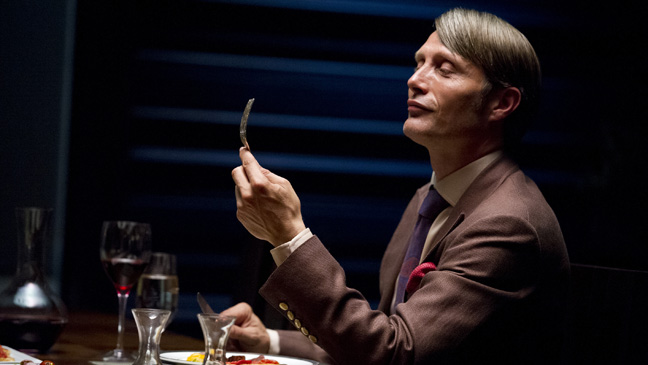 The first season of Bryan Fuller’s Hannibal was visually and aurally stunning, and the beautiful sounds and images were all in the service of crafting an excellent story. On May 30 it was announced that story would continue for at least one more season, and I hope we get six more. The series follows FBI Special Investigator Will Graham (Hugh Dancy) as he tracks serial killers under Special Agent Jack Crawford (Laurence Fishburne) who both regularly consult psychiatrist Dr. Hannibal Lecter (Mads Mikkelsen) with their personal and professional problems. What they don’t yet realize is that Dr. Lecter himself is the must cunning serial killer they’ve ever faced, and he has regularly been feeding them the people he’s killed. The series is based on the characters from the Thomas Harris novel Red Dragon, which will likely be the basis of season four (if the show lasts that long). I previously wrote about the use of art music to accompany violence in my post “Loki, Schubert, and the Art of Accompanying Ultraviolence,” and I want to briefly revisit the subject and the character of Hannibal Lecter in the wake of this excellent NBC series. My overall argument in the original post was:
The first season of Bryan Fuller’s Hannibal was visually and aurally stunning, and the beautiful sounds and images were all in the service of crafting an excellent story. On May 30 it was announced that story would continue for at least one more season, and I hope we get six more. The series follows FBI Special Investigator Will Graham (Hugh Dancy) as he tracks serial killers under Special Agent Jack Crawford (Laurence Fishburne) who both regularly consult psychiatrist Dr. Hannibal Lecter (Mads Mikkelsen) with their personal and professional problems. What they don’t yet realize is that Dr. Lecter himself is the must cunning serial killer they’ve ever faced, and he has regularly been feeding them the people he’s killed. The series is based on the characters from the Thomas Harris novel Red Dragon, which will likely be the basis of season four (if the show lasts that long). I previously wrote about the use of art music to accompany violence in my post “Loki, Schubert, and the Art of Accompanying Ultraviolence,” and I want to briefly revisit the subject and the character of Hannibal Lecter in the wake of this excellent NBC series. My overall argument in the original post was:
Using art music in these violent scenes gives us a glimpse into the madness of the character on screen. For characters like Hannibal Lecter and Alex DeLarge, killing is elegant, plaintive, and tender. They find beauty in it. And when Loki sees how much chaos he creates with violence, he finds beauty in it too.
The images and sounds used throughout the season were really exquisite (just look at all the planning that goes into how the food looks). Erik Adams at the A.V. Club already wrote about the importance of music to this show, but as a musicologist, I want to expound upon the role of music in the show’s soundscape in creating a uniquely chilling atmosphere while providing helpful insight into the characters. The importance of music to the show is reinforced by how often Fuller and others who worked on the show have referenced its “operatic” quality.
Much of the credit for the show’s soundscape goes to composer Brian Reitzell. The non-diegetic music is unlike anything else currently found on TV, and I’m still surprised that NBC executives let this show air with so many non-traditional elements (it’s much more like something you would find on Showtime or HBO than broadcast television). In an interview with Film Music Magazine, Reitzell said he was constantly disturbed by the show, which he tried to convey through sound. He said, “The show is very disturbing especially the story. Visually it’s so artfully done and quite fantastical, so I see it like an opera staging, otherwise I might be more disturbed. Listening to the music alone is scarier than in the context of the show.” To get an idea of the eerie music he is creating, listen to the opening credits and the use of dissonance, distortion, and non-Western percussion instruments.
Reitzell’s sounds are almost ever-present throughout the show. They change from scene to scene to reflect where the characters are and what they’re doing (I hope he sticks around so we can hear how he might use bronze instruments to bring the Tooth Fairy and his fascination with Asia to life in season four), but there’s a consistently unsettling quality to the music even if you’re not aware that you’re actually hearing it. He said, “Our music is very complex for standard TV speakers so I’m sure some elements do get lost like some of the lower pitched atmospheres and basses. Many people won’t hear all the cool surround stuff we do because they don’t have a surround system.” The music takes on a very important and clear role, however, when we go inside Will Graham’s (less-than-healthy) head. Watch this clip from the Pilot and notice how the music swells as Will steps into the mindset of the Minnesota Shrike and realizes what he’s been doing to his victims.
Immediately following that scene, we meet Dr. Hannibal Lecter for the first time. We see him sitting alone in his apartment, carving and eating a cut of meat while listening to the Aria from Bach’s Goldberg Variations. The use of music in this scene serves dual functions: it helps establish the character of Hannibal Lecter while also referencing one of his previous depictions as played by Anthony Hopkins (he listened to the Goldberg Variations during his breakout in The Silence of the Lambs, as described in my previous post). Classical music in the show has a different function than Reitzell’s score, because we can usually assume the classical music in the show is diegetic. This means that when the viewer hears the Adagio from Mozart’s Clarinet Concerto in A Major, it’s because Dr. Lecter and the Crawfords are listening to it as they eat dinner. Hannibal himself is a musician; he has a harpsichord in his office and claims to play the theremin (I really hope we get to see a “Hannibal plays the theremin” scene in season two).
Classical music helps the viewer understand Hannibal Lecter’s appreciation of elegance and beauty. According to Fuller, “For Hannibal, it’s really about food as art and also, Hannibal’s specific brand of art.” The pairing of art music with Lecter’s unique brand of fine dining helps us realize that Lecter considers his food (and by association, his murders) to be a work of art complete with the intricacies of a Bach fugue. This tumblr page lists all the pieces music used in the first season with a brief description of when they appear. Most of them are only heard when Hannibal is on screen and 15 out of the 23 times pre-existing art music is used, it involves Hannibal serving or preparing food either in his dining room or a kitchen.
The importance of art music extends beyond the character of Hannibal Lecter as well, and the metaphor of the operatic has been used as a metaphor for the show’s heightened reality and variety of killers. Showrunner Bryan Fuller spoke about this in an A.V. Club interview:
We stopped and were like, “What is unique to our Hannibal story? What is unique to the type of killers you’re going to see on this show that differentiate it from the killers you see on any other show?” And we just started leaning toward the purple and the operatic.
The various murderers that Will Graham and Jack Crawford track down take on this purple and operatic quality as they do things like bury catatonic humans to act as living fertilizer, flay and position corpses to appear like angels who watch over them as they sleep, or stack corpses to create a human totem pole. In the heightened reality of the show, the directors have created something visually appealing out of these horrific acts, and the show’s soundscape accentuates this uncomfortable juxtaposition.
In episode 8, music becomes a major theme. As previously described, art music functions partly as a metaphor for Hannibal’s “art” but in this episode that metaphor is realized in the character of a killer luthier who creates gut strings out of his victims to literally make music. The FBI begins investigating the case after he killed a trombonist from the Baltimore symphony in order to use his vocal chords as strings and play them like a cello. This episode is also when Will starts experiencing auditory hallucinations, so there are times for both Will and the viewer when the lines between diegetic and non-diegetic sound becomes blurred as he struggles to determine what he hears is and isn’t real. While the show’s soundscape is important throughout the series, in this episode it took on an especially important narrative function.

There are other clever uses of pre-existing art music in the show. One that stuck out to me was the use of music from Gounoud’s Faust. This was fitting for Mads Mikkelsen’s depiction of Hannibal Lecter, which he describes as inspired by Lucifer himself. According to Fuller, Mikkelsen said, “This character is a bit like Lucifer. He sees the beauty in the world and in humanity but is also punitive to those who don’t recognize beauty in the world and in humanity.”
While art music has been a part of depicting Hannibal Lecter on screen before, it has not taken on the importance to the overall world of Hannibal Lecter as it does in this show. As a point of comparison, I recently finished reading Red Dragon and two times the Tooth Fairy Killer is described listening to art music on the radio, once with Debussy and once with Handel’s “Water Music.” While not specifically addressed, I assume a reason for it could be that the character never dared change the radio dial from the station his domineering grandmother listened to. However, in the first film adaptation of the book, Michael Mann’s 1986 Manhunter (featuring the first on screen depiction of Lecter and starring the late, great Dennis Farina as Jack Crawford), there is no art music and the soundscape of the film is dominated by original synthesized music by The Reds and Michael Rubini along with sounds like the shakuhachi that evoke the killer’s Asian influences. The one piece of diegetic music was Iron Butterfly’s “In-A-Gadda-Da-Vida,” which the Tooth Fairy blasts to keep his kidnapped victim disoriented and is in line with the use of heavy metal or dark electronica by killers in many other films.
Alternatively, the soundscape of Hannibal is unique and I look forward to it continuing for multiple seasons, which will hopefully include Fuller’s versions of Red Dragon and The Silence of the Lambs. I also have high hopes for more fun musical connections, as there are rumors that David Bowie may guest star as Dr. Lecter’s uncle in season two. If you missed Hannibal when it first aired, I strongly encourage you to catch it on DVD, Blu-Ray, or streaming (when that’s available) before season two. NBC has finally put a great drama on the air, and I hope it gets the support it deserves so that we can keep experiencing its horrific beauty until the story reaches its conclusion.
I leave you with this great ironic mashup featuring images of Dr. Lecter’s beautifully-prepared food accompanied by Cab Calloway’s “Everybody Eats When They Come to My House.”


The music sounds like it came out of an FM Einheit album, an Einsturzende Neubauten album, and a Throbbing Gristle album.. all at the same time. I’m sure Brian Reitzell knows about these bands and their influences.